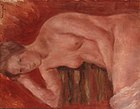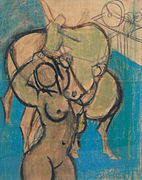Joachim Weingart
Joachim Weingart (also: Joachim Weingarten , * 1895 in Drohobycz , † 1942 in Auschwitz concentration camp ) was a Polish painter of the Jewish faith . He is counted among the outstanding Polish representatives of the École de Paris .
Life
Weingart was born to Jewish parents in the village of Drohobycz, which at that time belonged to Austria-Hungary and was located near Lviv . His father was a wine merchant who died early; the mother had to raise the two underage sons. After attending a grammar school in Lemberg, Weingart began training in drawing at the Weimar School of Applied Arts in 1912 . From 1914 he continued his education at the Academy of Fine Arts Vienna . It was exhibited for the first time in the Technical Art School in Lviv. With the help of a scholarship from the industrialist and art patron Carol Kratz , he was able to go to Berlin in 1916 . After the First World War he returned to Galicia and exhibited in Łódź . During a subsequent stay in Berlin in 1922 he met the painter Zygmunt Menkes in Alexander Archipenko's studio , with whom he moved to Paris in 1923. The two friends lived there in the “Hôtel Medical”, where Eugeniusz Żak and Marc Chagall also lived at the time.
In Paris Weingart joined the artists of the École de Paris . With his Polish compatriots Alfred Aberdam , Leon Weissberg and Zygmunt Menkes, he founded the artist group “Gruppe der Vier” (Polish: Grupy Czterech , French: Le groupe des Quatres ) in 1924 . The art forms represented by this group were part of the expressionist movement in the École de Paris . The group existed until 1925, together they exhibited in 1925 in the gallery “Au Sacre du Printemps” run by Jan Śliwiński . In 1925 Weingart moved into a studio in Montparnasse .
In 1930 Weingart signed a contract with the art dealer René Gimpel . After his marriage to the daughter of a French doctor broke up and she left him with their son, he fell ill with depression and was temporarily hospitalized. On April 30, 1942, he was arrested by German troops in his studio, interned in Pithiviers , deported to the Auschwitz concentration camp on July 17, 1942 , and murdered there. In the same year his brother took his own life.
Weingart had two solo exhibitions in Poland - with the Academy of Friends of Fine Arts in Lemberg in 1923 and in 1932 with the support of the Jewish Society for the Promotion of Art in Warsaw. In Paris he exhibited in 1926 at the Salon des Indépendants and in 1929 at an exhibition of Polish art in the Bonaparte Gallery .
Weingart mainly painted figural compositions, alongside nudes , still lifes (often flowers) and landscapes . The compositions are characterized by the use of yellow-brown and reddish tones. Particularly noteworthy are the Jewish motifs in Weingart's work. B. the painting “Young Jew holds the Torah ”.
gallery
Individual evidence
- ↑ a b c according to Pamiętnik sztuk pięknych , editions 1–5, Copernicus University Toruń, Toruń 2001, pp. 5, 40 u. a. (in English)
- ↑ Kratz also supported Alfred Aberdam and David Seifert
- ↑ according to Natasza Styrna, Artyści żydowscy w Krakowie 1873–1939 , exhibition catalog, Historical Museum of the City of Krakow (ed.), Krakow 2008, pp. 27 and 66
literature
- Władysława Jaworska, Agnieszka Morawińska u. a., Malarstwo polskie w kolekcji Ewy i Wojciecha Fibakow (Polish painting in the Ewa and Wojtek Fibak Collection) , Auriga Verlag, ISBN 83-221-0623-8 , Warsaw 1992, pp. 190 f.
Web links
- Brief curriculum vitae with Nadine Nieszawer, School of Paris 1905–1939 (in English)
- photos
| personal data | |
|---|---|
| SURNAME | Weingart, Joachim |
| ALTERNATIVE NAMES | Weingarten, Joachim (full name) |
| BRIEF DESCRIPTION | Polish painter |
| DATE OF BIRTH | 1895 |
| PLACE OF BIRTH | Drohobycz |
| DATE OF DEATH | 1942 |
| Place of death | Auschwitz concentration camp |




